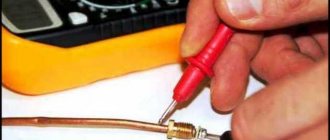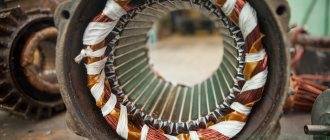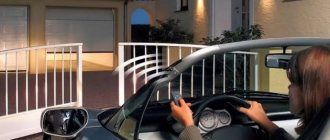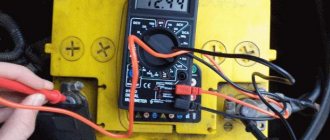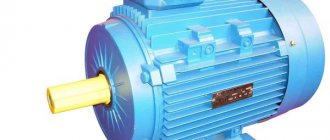Correct operation of the Makita 2450 rotary hammer with a commutator motor is accompanied by slight sparking of the brushes in the commutator area. A properly functioning electric motor has a uniform spark with a short tail.
By changing the sparking pattern, you can determine the nature and location of the malfunction in the Makita 2450, 2470 hammer drill.
The reasons for the increase in sparking in the electric motor commutator may be faulty brushes and their wear, short circuit or armature breakage, malfunction of the stator windings of the electric motor, breakage or improper fastening of brush holders.
Significant sparking in the commutator area leads to the appearance of grooves on the commutator, burning of the plates, and uneven abrasion of the brushes.
The occurrence of the listed defects causes rapid wear and wear of the lamellas of the collector itself.
Roughness is higher than normal
Since a hammer drill is a powerful tool, small sparks are allowed without load; with significant effort on the tool, single sparks may run in a circle. In case of strong sparking, it is necessary to find out the reason for the strong sparking.
The most common fault on the commutator is the increasing roughness of the lamellas with increasing sparking of the brushes.
An increase in the surface roughness of the Makita 2450 rotary hammer commutator occurs not only due to increased sparking. Copper oxide forms on the copper plates of the commutator; its hardness exceeds the hardness of the carbon brushes. The amount of roughness is affected by uneven wear of brushes and carbon deposits from sparking.
Scratches are formed not only due to uneven wear of the brushes and different structure of the material, but also due to the entry of solid particles from the air into the working area.
Improper storage of a Makita rotary hammer can lead to the appearance of oxide on the copper plates of the collector due to high humidity or significant temperature changes during operation.
To eliminate defects on the surface of the collector, it must be sanded.
How to properly sand the surface of the commutator
Before you begin to modify the manifold of the Makita 2470 rotary hammer, you must balance the rotor.
Option for measuring the runout of the commutator relative to the rotor
At home, grinding the manifold of a Makita 2450 or 2470 rotary hammer is best done with sandpaper attached to a wooden block already on a balanced rotor.
The end of the rotor shaft is secured in the drill chuck through soft copper or aluminum foil. A drill with a rotor is securely fastened in a vice or homemade device.
While rotating the rotor, try to center it in the drill chuck.
Installing the rotor into the chuck
Scope of application of electric motors with wound rotor
Due to their high torque, low starting currents and the ability to operate for a long time at high loads, motors with a wound rotor are used where high electric motor power is needed, but there is no need to smoothly regulate the rotation speed over wide ranges. In addition, these machines are perfectly suited for starting with a load on the shaft.
Due to their high performance, wound rotor motors are most often used on various serious, heavy power equipment, for example, cranes, elevator drives, machine tools, and various lifts. In other words, these engines are used where there is a need to start under load, and not at idle.
How to center the rotor in a drill before grinding
The rotor is centered in the drill chuck to ensure minimal runout of the radial surface of the commutator relative to the rotor shaft.
First check the runout of the chuck jaws. Secure the drill in a vice, install a drill of the largest diameter in the chuck.
While rotating the drill, bring a pencil to the rotating side surface of the drill, resting it on a simple stop. With minimal runout, the pencil will draw a solid line on the surface of the drill. If the runout is significant, change the chuck in the drill or select a drill with less chuck runout.
Now, instead of a drill, clamp the rotor shaft and in the same way determine the runout locations of the rotor or commutator.
Mechanical repair
When repairing the shaft, the following damage may be detected in the form of irregular bends, cracks or deformations, small scuffs and scratches from the journals. Problems also include general wear of the shaft, collapse of special channels, collapse and wear of the threads at the ends of the shaft.
This is a responsible process that requires not only an understanding of the matter, but also the availability of a motor diagram, since the specific features require special tools and an understanding of the core design. In the process of repairing the frame, emphasis is placed on fast and high-quality welding of cracks and welding of broken legs.
It is also possible to eliminate elements in the seats and restore damaged threads in holes with the removal of the remaining torn elements. High-quality maintenance and repair of an asynchronous motor allows you to keep the machine in good condition for a long period of time.
Commutator grinding process
The process of grinding the collector must begin with the selection of sanding material. It is recommended to use sanding paper or a file to sand the commutator.
Choose several sizes of sanding paper, starting from #100 and above.
Now start sanding. Applying a wooden block with sandpaper attached to the commutator, rotate the drill and, without pressing the block too hard to the surface of the commutator, grind.
Grinding the commutator in a drill
It is recommended to use the grinding operation on already operating rotors with minor wear on the commutator.
Proper brush sparking
If you have replaced the commutator on the rotor of the Makita 2470 rotary hammer, then after installing it on the shaft, the commutator must be machined. This operation is performed to eliminate radial runout of the surface of the lamellas of the new collector relative to the armature shaft.
It is best to grind the manifold on a lathe using mandrels. But this operation can also be performed at home. True, you can’t do it without an additional device. The video will help you understand the manifold groove.
As a rule, brush holders on hammer drills are mounted opposite each other. Prolonged operation of the brushes leads to the formation of grooves on the collector, creating waviness on the surface. Such wear can only be eliminated on a lathe by turning the commutator.
To reduce the formation of grooves on the commutator, you should try to arrange the brush holders in a checkerboard pattern.
Components
The cylindrical shaft is made of steel. Sheets of electrical iron with grooves or slotted holes are assembled onto the shaft. Holes or cuts are made in the sheets, which are called keys (to assemble a package of sheets into one structure).
The number of revolutions of an electric motor's stator determines the number of holes or slots in the rotor. Holes or grooves help create short-circuited turns of the squirrel cage in it. The coils are formed by pouring low-melting metal with high electrical conductivity into them under pressure.
A short-circuited device during operation is exposed to destructive forces. The following nodes are affected by it:
- iron package,
- shaft bearing units;
- coil filling rods.
Engine repair tools.
The breakage of the last elements among the faults of an asynchronous type electric motor takes no more than 0.3-0.5%. Due to a breakdown, the heating of the equipment increases, the power of the electric motor is lost, and the current consumption increases 5-6 times. The absence or malfunction of protective mechanisms contributes to the breakdown of the electric motor. A failed device does not need to be replaced with a new analogue by repairing the stator. The device is first diagnosed. It is performed in 2 ways.
There is equipment on the market that helps test brushed electric motors for the presence of short-circuited turns in the winding. Using such devices, you can check for breakage of a low-power rotor.
Another method is to connect the transformer to short circuit rings. The voltage on the secondary winding should be 1-3 V. Metal filings are poured onto the surface of the rotor. The tracks formed along the rods will indicate their integrity. Otherwise, their integrity is compromised.
How to clean the slots of a rotary hammer manifold
But the grooves between the lamellas must be cleaned, since micanite, the material of the gaskets between the lamellas, is harder than copper lamellas and wears out less. Over time, micanite spacers wear less, and their height exceeds the height of copper lamellas.
To equalize the heights, the grooves between the lamellas are milled, or, in simple terms, resurfaced.
Do-it-yourself milling is best done with a piece of metal saw sharpened to the width of the collector grooves.
Milling grooves by hand
A metal ruler is applied parallel to the edge of the groove, the saw is pressed against its edge and pulled out with gentle pressure. The groove is milled to the height of the copper lamella.
Milling of grooves ends by removing the remaining material using a hair brush and chamfering using a scraper made from a needle file. It is better to sand with felt.
Any milling should be completed by grinding and blowing air.
The level of collector output is also affected by the condition of the bearings. Worn bearings lead to increased commutator runout, which in turn leads to accelerated wear of the carbon brushes. To eliminate collector runout, it is recommended to replace suspicious bearings with new ones.
Advice from the experts
Depending on the type of breakdown, repairs may take a long period of time. If you do not have certain skills in working with electric motors, understanding the circuit diagram of the device itself, or additional parts, it is not recommended to carry out repairs yourself.
If the engine is not operating properly, you can re-diagnosis or correct its elements. A mandatory point of correctly performed work is testing the electrical insulation strength and checking the motor in test mode.
How to check the condition of the brushes
When installing new carbon brushes, it is recommended to grind them in for a better fit to the commutator surface.
It is best to adjust carbon brushes using a homemade grinder. The lap is a shaft on which sandpaper is attached. The easiest way is to make the shaft from wood with a diameter equal to the diameter of the commutator, turning the workpiece on a lathe. A metal rod is inserted tightly along the axis inside the shaft. The device is attached to the chuck of an electric drill, the drill is turned on, and the brushes are brought to a rotating emery wheel.
The adjustment should be carried out carefully, periodically applying the brushes to the rotor commutator to check their clearance.
Having ground the brushes to the commutator, it is recommended to check the correct fastening of the brush holders before installation. When factory installed, the brush holders are set to neutral, which minimizes sparking on the commutator. If there are no factory marks, then the installation of the brush holders is adjusted by moving the brush holder in the direction opposite to the rotation of the rotor until a minimum spark is formed.
The brushes should not dangle in the brush holder, but should be pressed tightly against the commutator lamellas. The pressing force is regulated by springs in the brush holder.
Sparking faulty collector
An increase in sparking on the rotor commutator may appear due to a short circuit of the armature, a break in the armature coils, or a short circuit of the windings to the armature body. All these faults can be eliminated only with a major overhaul of the rotor.
Occupational Safety and Health
While working, craftsmen must wear special clothing that will protect them from small parts and possible injuries.
When repairing the rotor of an asynchronous motor, you must be careful not to catch clothing or additional material in the rotating parts. Do not touch live parts or grounded wires on the machine with your hands.
To do this, you need to use special tools that have insulated handles. Otherwise, you need to turn off the engine and only then continue repair work.
When impregnating and drying windings, the impregnated chamber must be equipped in accordance with safety requirements. Smoking and open fire are prohibited in the room where the electric motor is being repaired.
